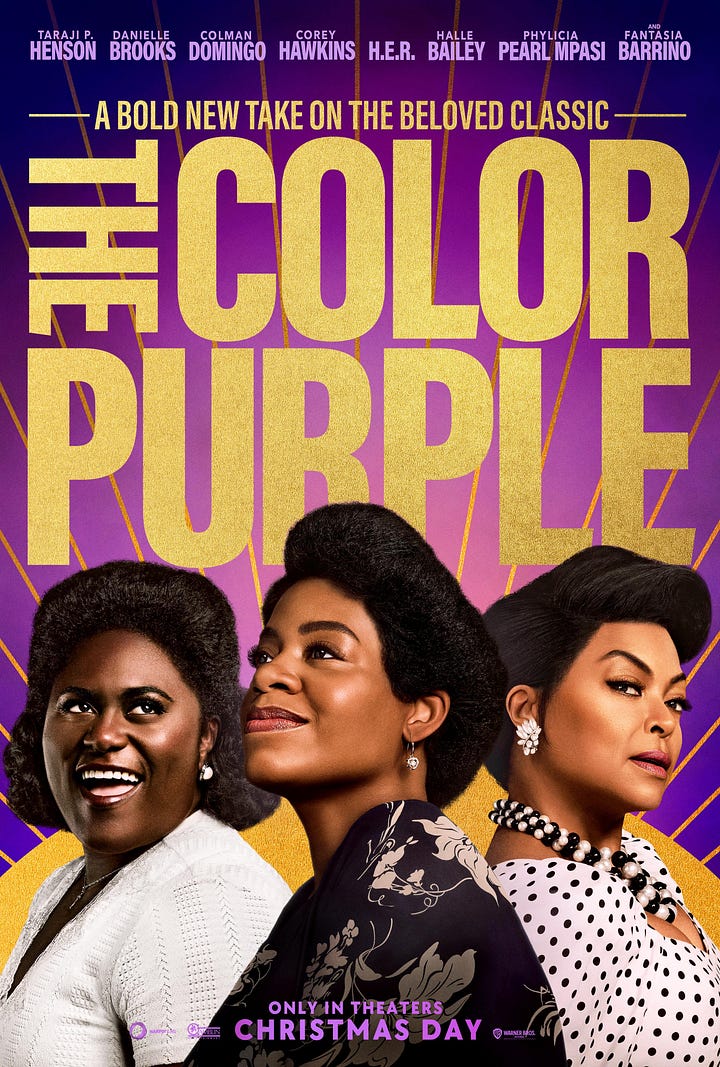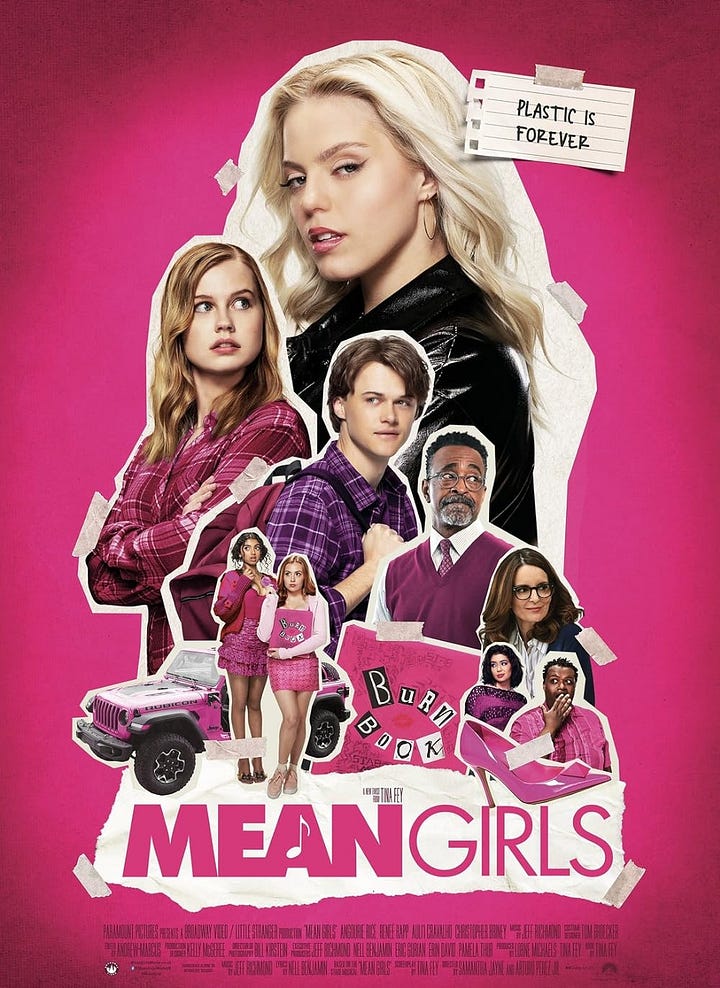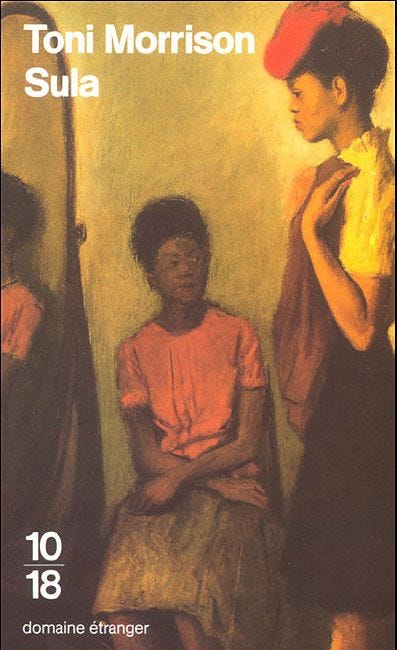

What to say about all the movie musicals for 2024: The Color Purple, Mean Girls, and Wicked (releases in November). But I want to return to friendships because 1) that’s what’s connecting all these movies for me, and 2) I am still pulling together my thoughts on friendship for an essay. I am also at the age when women often examine their circles.
Both movies deal primarily with relationships among the “girls, gays, and theys.” In The Color Purple, we watch interactions between Celie and her sister Nettie, Celie and her lover Shug Avery, Celie, and Sofia. In the book, the dynamics between Celie, Shug, Sofia, and Mary Agnes (Squeak) develop. Mean Girls revolves around “girl world.” Obviously, Barbie deals exclusively with “girl world.” Arguably, Wicked wants to understand how two women maintain their friendship despite their diverging paths. In a time where women’s bodies and actions see increased policing and violence, our entertainment becomes escaping to “girl world” for laughs, tears, and a lot of singing and dancing.
The depictions of friendship vary across these movies, Wicked excluded obvi, and so we see different definitions of what “girl world: and girl-centered communities can look like. These communities, at their worst, can reinforce some of the worst of the #girlboss era or offer a better understanding of the kind of support and community needed to be successful right now.
The Barbie movie depicts very few meaningful relationships or social dynamics on the girl boss end of the spectrum. We see Barbie’s world, not Barbie’s community, where she fits into a web of neighbors, friends, and family. Besides Barbie, Gloria, and Gloria’s daughter Sofia’s interactions, the movie does not provide much detail about how individuals in Barbie’s world work together. Even in the scenes where Issa Rae’s Barbie character presides over the Barbie government, discussion doesn’t happen. Things seem to run without much work on their part. I’m not surprised when their world crumbles so quickly because there seems to be no evidence of community development on their part.
While the musical softens the original movie’s wit and humor, Mean Girl’s social dynamics have more substance. Cady, Regina, Gretchen, and Janice all, at some point, fumble while finding the right group for their developing identities. We see these women make choices daily about how to treat the women around them. Will Cady be the kind of girl who goes to Janice’s art show or throws a party with the plastics? Ironically, Cady’s lesson actually comes from Regina George and Janice. Both understand that “girl world” achieves equilibrium when these young women invest their time and energy into their authentic identities and the communities that support them. In the 2004 film, Regina becomes a lacrosse player, Karen joins a journalism club, and Cady joins Mathletes. (Gretchen in both movies does not have a satisfying arc, so ignoring that.)
Finally, The Color Purple shows Black women developing identities, communities, and relationships in the Jim Crow South at the turn of the century. What was beautiful about the book, 1985 film, and 2023 movie musical was how these women stepped up and in for each other. Between Sofia, Celie, Mary Agnes, and Sofia’s family, everyone’s child gets food and some attention despite the arguments and fights. When white officers arrest Sofia for refusing to be the mayor’s wife’s maid, everyone steps in to help her children. Celie and Sofia’s argument made me cringe each time. I, too, have had to learn what it means to be a girl’s girl the hard way. However, the message went over better with Danielle Brooks’ powerful and comedic “Hell No!” performance. The moment could have been heavy and shaming for Fantasia’s character’s poor decision. Instead, Brooks’ body humor shines a light on Celie’s choices and the control she lacks.
After Alice Walker authored The Color Purple in 1982, she released In Search of Our Mother’s Gardens, where she explains her concept of womanism in the preface. Her definition does not look exactly like those in Merriam-Webster. There’s poetry, dialogue, and scene. To be a womanist requires a shift in lifestyle, not just a theoretical understanding of terms. A Black Woman frees her soul to shift and move in the ways needed to love herself and her people deeply. Walker’s novel portrays different ways women love and learn to love without labels, borders, or limits. The women in the movie musical exude that love as they navigate their journeys.

(I will admit that I found Albert foppish in this iteration. Overall, his character and the place of men in the book get buried under projections and deliberate misreadings.)
Right now, I am fascinated by all the movies and movie musicals that want to think about the female gaze, girl world, or women’s culture, however you want to describe it. These movies can open up discussions about whether women do or don’t make space to be their authentic selves or build communities that align with those goals. I’m also looking forward to new and different understandings of women’s culture versus revamps of older movies. However, that’s a critique for another time.
For more from me about friendships, read:
Back to female friendships
I read a whole lot of smutty self-published online fiction. Usually, I am swiping furiously on the Kindle app, skimming a formulaic, cliche, and incredibly juicy ebook. They are a guilty pleasure. Like a double fudge brownie sundae, reading these books provides no emotional, spiritual, or personal nourishment. It’s all about fun and indulgence.
It is what it is
Excuse the brief hiatus as I furiously tried to clear my desk of things I owed folks. I am still trying to figure out how to work on this blog and will need to work on how to put this into my schedule. I had been meaning to write this on finally finishing





